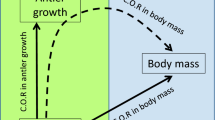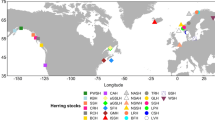Abstract
Relationships between body storage (estimated as fat content and residuals of body mass regressed against body length) and offspring investment [brood mass, brood size (number of embryos per brood) and embryo mass] were examined within and among populations of the amphipod Gammarus minus in ten cold springs in central Pennsylvania, USA. Two major hypotheses and six corollary hypotheses were tested. Total reproductive investment (brood mass and brood size) was usually strongly positively correlated with maternal body length and body storage both within and among populations. These positive associations between reproductive and somatic investments are expected if individual variation in resource acquisition exceeds that of resource allocation. That is, individuals or populations that are able to acquire more resources should also be able to allocate more resources to both reproduction and somatic reserves than those acquiring fewer resources. This hypothesis is consistent with evidence showing that individual differences in body storage in G. minus and other amphipods are related to differences in resource acquisition. Positive associations between reproductive and somatic investments do not mean that energy costs of reproduction do not exist in G. minus. Evidence for reproductive energy costs included the lower body-fat contents of brooding versus nonbrooding females and the relatively low body mass per length of females who had just deposited eggs in their brood pouch. Unlike brood mass and brood size, individual embryo mass was usually unrelated to maternal body length and body storage. This pattern is largely consistent with optimal offspring investment theory, which predicts that offspring size should be insensitive to variation in parental resource status. However, in contrast to theory, embryo mass increased in winter when brooding females were significantly ”fatter”, presumably due to the availability of autumn-shed leaf food. This seasonal change in offspring size may be a maternally mediated effect of increased resource availability, though other explanations are possible. Overall, this study suggests that ”fatter” female amphipods are fitter than ”thinner” ones, though both the costs and benefits of increased body storage and brood size require investigation to substantiate this claim. This study also suggests that effects of individual variation in resource acquisition on life-history patterns deserve more theoretical and empirical attention by ecologists than they have received. It should be recognized that positive and/or nonsignificant correlations between life-history traits are just as interesting and important as are the negative correlations predicted by many theoretical models.
Similar content being viewed by others
Author information
Authors and Affiliations
Additional information
Received: 20 January 1999 / Accepted: 26 September 1999
Rights and permissions
About this article
Cite this article
Glazier, D. Is fatter fitter? Body storage and reproduction in ten populations of the freshwater amphipod Gammarus minus . Oecologia 122, 335–345 (2000). https://doi.org/10.1007/s004420050039
Issue Date:
DOI: https://doi.org/10.1007/s004420050039




